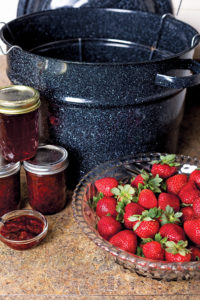The centuries-old practice of preserving food, or “putting up,” as it is called in canning lingo, is making a big comeback. People are more interested in healthy eating and growing their own food or celebrating the bounty at local farmers’ markets. Home canning is a great way to preserve garden produce to enjoy the season’s fresh flavor for months to come, and share it with family and friends. Best of all, canning is easy and fun!
There is more to home canning than simply having flavorful ingredients on hand for off-season cooking. It also preserves memories. Imagine opening a jar of vibrant red tomatoes on a cold winter day to add to your favorite soup or stew. Pop open the lid and it smells like summer! You can almost feel the warm Texas sun on your shoulders from when you picked the ripe fruit off the vine. You might even recall that delicious moment in time when you helped your grandma put up the peach preserves, the sweet fragrance lingering in the air.
It was not that long ago that everybody canned. Chef Sandra Jones, the executive chef and owner of Fresh from the Gardens Culinary Experience, is on a mission to help people recapture the lost art of canning. Chef Sandra shares, “I was born and raised in Denison, Texas, and grew up in a family with a long history of gardening, canning and cooking meals using ingredients fresh from the garden. My mom and dad are still gardening and canning in their 90s! I continue to carry on the family tradition. I left my corporate career after 20 years to pursue my passion for canning, cooking and creating dishes from fresh, organic ingredients. I obtained a degree from the Culinary Business Academy and started my own personal chef and canning business.”
Canning your own fruits and vegetables allows you to put exactly what you want in the jar. Home canned fruits and vegetables are free of preservatives, colorants and added flavorings. Chef Sandra adds, “You control everything that goes into it, like organic produce, honey instead of sugar or even simply reduced levels of sugar. Home canned products make excellent personalized gifts for the holidays,  house-warming parties or for any occasion. Also, you can save money and eat healthier by canning your own garden-fresh fruits and vegetables.”
house-warming parties or for any occasion. Also, you can save money and eat healthier by canning your own garden-fresh fruits and vegetables.”
While there is an upward trend in home canning, some people still shy away from it because they are unfamiliar with or intimidated by the process. Chef Sandra smiles, saying, “People think canning is hard to do, or they are afraid they will blow something up or poison someone. They worry ‘Am I doing this right?’ ‘What is the best method?’ The truth is, canning is not complicated. There is really no magic as to how the canning process works, but it is very important to understand what you are doing.”
One of the most common concerns involves what foods canners can actually preserve. Chef Sandra explains, “The short and easy answer is just about anything. You can preserve everything from seasonal fruits and vegetables to meats and seafood. You also need to know the tools needed, the different canning processes, which method is right for you and the product you want to preserve.” Chef Sandra advises, “You do not need a lot of expensive equipment to begin canning. Just be sure all equipment used for canning is thoroughly cleaned, including jars and lids. It is really important to have a good, reputable canning book. Do not rely on the Internet. I have seen too many recipes online that are unsafe. Also, make sure you do not alter the recipes.”
The basic canning tools and supplies include a plastic or stainless canning funnel, a stainless steel ladle, canning jars and new lids, a canning jar lifter, a magnetic lifter and bubble remover, a water bath kettle (or large stock pot), a pressure canner (if processing low acid foods like meats and vegetables), a magnetic lid lifter and a good canning book. r
Water Bath Canning
rAll high-acid foods should be heat-processed in a boiling water canner. This includes jams, jellies, preserves, marmalade, fruit, pickles, relish and tomatoes with added acid. In this method, jars of food are heated completely covered with boiling water and processed for a specified amount of time.r
Pressure Canning
rAll low-acid foods must be processed at a temperature higher than boiling water in a pressure canner. Higher temperatures are required to destroy naturally-occurring spores that can cause botulism. Pressure canning must be done for the designated time for the specific food and size of canning jar. Low-acid foods include vegetables, tomato products with added vegetables or meat, meat and game, soups, stews, seafood and poultry.
Once jars are filled, sealed and placed in a canner filled with water, the process begins. As the heating begins, the contents of each jar expand, pushing out gases in the jar. Once the processing period is finished, the pressure outside of the jar is greater than the pressure inside. This pressure pulls the lid down onto the jar and forms a vacuum-tight seal. Heating for the required period of time also kills mold, yeasts, bacteria and enzymes that may be present. Your preserves now keep safely, as the vacuum seal prevents microorganisms and air from re-entering the jar and contaminating the contents. The average shelf life is about one year.
Chef Sandra says, “If you are looking to eat local and seasonal produce year-round, home canning is the most cost efficient preservation method that can also be a fulfilling hobby. Home canning provides a healthier alternative to store-bought goods because you are able to monitor the quality of food you feed your family, you know exactly what ingredients are added and you know you are eliminating added chemicals and preservatives. Additionally, canning can save money. Buying or growing produce and canning it in season is an inexpensive way to stock your pantry and have food available all year long.”
If you are still feeling a little trepidation about canning on your own, not to worry! There are classes available to help. Chef Sandra will be teaching a series of Holiday Canning Classes at the Tasting Room at Your Pro Kitchen in Plano during the months of November and December. Visit her website, freshfromthegardens.com, for more information and details.
The Collin County Farm Museum at Myers Park and Event Center in McKinney will also be offering canning classes. Jennifer Rogers, the museum coordinator, says, “We are excited to be offering canning classes this fall. Canning 101 - Hot Bath is scheduled for November 8 and the cost is $20. There are two time slots, 3:30-5:30 p.m. or 6:30-8:30 p.m. Canning 102 will focus on pressure canning and is scheduled for November 22, at the same time, for the same price. We will be offering more classes in spring 2017.” Visit collincountytx.gov for more details.
Canning is a great family or group activity and an excellent way to create lasting memories. With a little digging, you might find recipes from your own family that you can pass on to future generations. As Chef Sandra concludes, “There is simply no comparison to the flavor and freshness you get when canning your own food.”






